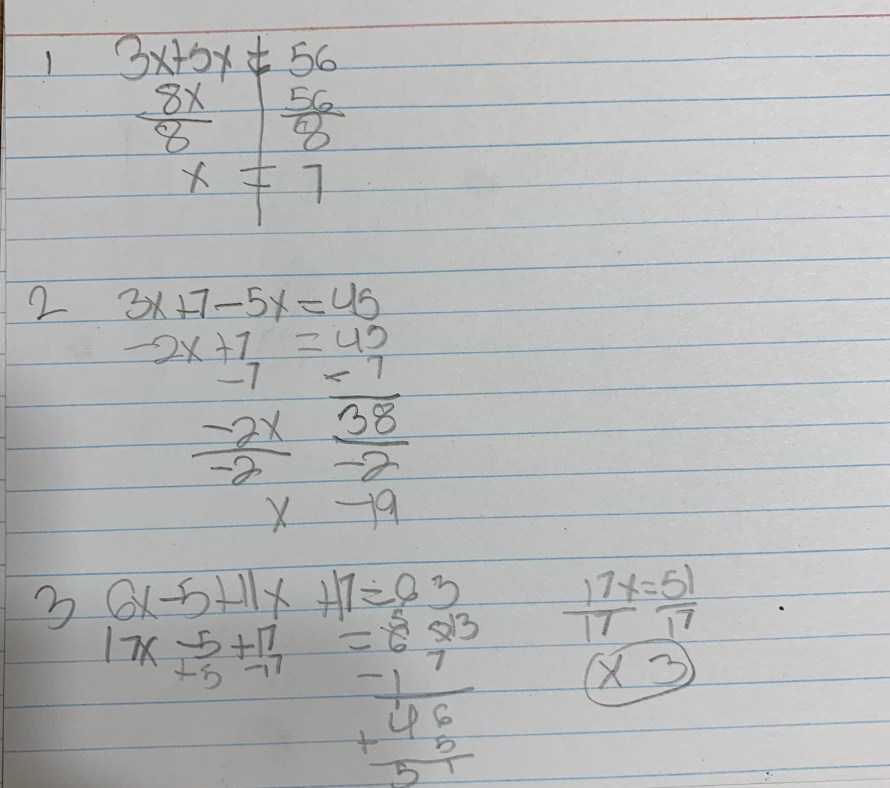Dear Aunt Sally,
My students had a hard time with my lesson on solving equations. How do I know? I gave a short “exit ticket” and the results were…mixed. There were three questions:
- 3x + 5x = 56
- 3x + 7 – 5x = 45
- 6x – 5 + 11x + 17 = 63.
The main issue is combining like terms. (I’ve included some pictures of student work for you, Aunt Sally.)


That said, some students in each class definitely did understand the material.

One more issue. In most of my classes, students didn’t struggle with the first problem. But in each of my classes, some students did, and in one of my classes very few students got that first one correct either.
What do I do to help the students who didn’t understand the material, and what do I do with the kids who did?
Ryan in Florida
***
Dear Ryan,
You have described one of the perpetual struggles of teaching. How do I balance the needs of the many versus those of the few? I suppose back in Neanderthal times the fellow charged with teaching youth to spear a mammoth came home to the cave feeling similarly. “Some of those kids get it,” he’d say. “But what about the one who used the flat end of the spear? He’s going to starve to death. He would really benefit from getting back to the basics. Maybe I’ll split the group in half?”
Thank goodness we aren’t Neanderthals. We are modern teachers! This means we have access to the wonders of modern technology. I of course mean the blackboard and copy machine.
My favorite way to follow-up on these sorts of quizzes is with examples, so I put together three such activities for you:



And then some mixed-up practice, to take another step in the right direction.
A good example activity, in my experience, can seem so simple so as to hide its design. And in fact the actual design of the student work was mostly straightforward. The choices to make are mostly ones I made long ago — to prefer simplicity, to subtly use arrows and lines, and to make the work as much like a student’s as possible while making the work as clear as possible to read.
(The mistake, in particular, closely follows the design of an Algebra by Example mistake.)
Most of the work here is in narrowing in on a specific type of problem that is worth including in the examples. (The simplicity of the format works well with the more complex task of narrowing in.)
Here is a rule I tell myself while looking at a student’s mistake: Every mistake points to a family of situations very similar to the mistake that the student doesn’t yet know how to handle. Find that family, and teach it!
In this case I don’t assume the mistakes on the second problem (3x + 7 – 5x = 45) point not to issues “combining like terms” in general. I assume instead that the mistake points to issues where the like terms are separated visually in the equation and where subtraction is involved. Those things are distinctive and make the equation more difficult to solve correctly — that is the family that I focus in on for the example.
How the examples are used is your decision, Ryan, but here is how I would do it. Begin class by showing just the example, and ask students to silently study it. (They can let you know when they’ve read it all with their thumbs.) When finished, you can ask them to answer the explanation questions on their own or with a partner. If you want to interject with an explanation, by all means, but often students are ready to dive straight into the practice problems.
There are three examples/non-examples I’ve made. Use as many as your class would benefit from.
Then, there are four practice problems. Those are important because they are mixed practice. If we see each of these examples as pointing to a micro-skill, a small family of problems within the broad category of “two-step equations,” then these problems are interleaved in the practice set. That can be useful! Your students will have to think back and remember what they did with the examples.
Teachers of equation-solving know that there are always more mistakes that need to be addressed. The difference between good and bad teaching of this topic, as I see it, is whether the teacher can get specific and point to precisely what is hard for their students. Subtracting, different visual formats, handling a variable with coefficient 1 (x as 1x), and so many other little things — there will always be more of these. Some teachers just repeat and repeat and repeat without getting any more specific. Instruction should get more specific as practice gets more general.
So, keep at it! Pretty soon your young charges will be scattering the landscape with Woolly Mammoth carcasses, so to speak.
-Aunt Sally
Pingback: Bandaids and Strider Bikes – Arithmetic Plus
Cute framing. Btw: how does read for more work in practice?
Cute?! I think you misspelled “stunningly brilliant.”
Seriously, I love advice columns. When it comes to doing my own job, I barely make it through the week. I get so excited when people ask me questions.
What does “read for more work” mean?
Aargh – make that “Ready For More” not “Read for More” as in the final section.
Ben
It’s just a neutral way to say “extra credit” or “try this, but don’t stress if you don’t get to it.” I stole it from Ben Blum-Smith slash Illustrative Math.